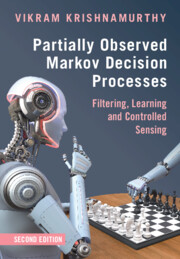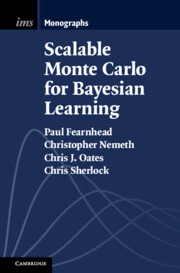Refine search
Actions for selected content:
52379 results in Statistics and Probability
Non-homogeneous and time-changed versions of generalized counting processes
- Part of
-
- Journal:
- Advances in Applied Probability , First View
- Published online by Cambridge University Press:
- 27 May 2025, pp. 1-37
-
- Article
- Export citation
Diffusion approximation of the stationary distribution of a two-level single server queue
- Part of
-
- Journal:
- Advances in Applied Probability / Volume 57 / Issue 4 / December 2025
- Published online by Cambridge University Press:
- 27 May 2025, pp. 1167-1205
- Print publication:
- December 2025
-
- Article
- Export citation
Steady-state Dirichlet approximation of the Wright-Fisher model using the prelimit generator comparison approach of Stein’s method
- Part of
-
- Journal:
- Advances in Applied Probability / Volume 57 / Issue 4 / December 2025
- Published online by Cambridge University Press:
- 27 May 2025, pp. 1321-1359
- Print publication:
- December 2025
-
- Article
- Export citation
On the edge eigenvalues of the precision matrices of nonstationary autoregressive processes
- Part of
-
- Journal:
- Advances in Applied Probability / Volume 57 / Issue 3 / September 2025
- Published online by Cambridge University Press:
- 27 May 2025, pp. 907-939
- Print publication:
- September 2025
-
- Article
- Export citation
Statistical models for improved insurance risk assessment using telematics
-
- Journal:
- British Actuarial Journal / Volume 30 / 2025
- Published online by Cambridge University Press:
- 26 May 2025, e16
-
- Article
-
- You have access
- Open access
- HTML
- Export citation
Asymptotic behaviors of subcritical branching killed Brownian motion with drift
- Part of
-
- Journal:
- Advances in Applied Probability / Volume 57 / Issue 4 / December 2025
- Published online by Cambridge University Press:
- 26 May 2025, pp. 1484-1509
- Print publication:
- December 2025
-
- Article
-
- You have access
- Open access
- HTML
- Export citation
Limit laws for the generalized Zagreb indices of random graphs
- Part of
-
- Journal:
- Advances in Applied Probability / Volume 57 / Issue 4 / December 2025
- Published online by Cambridge University Press:
- 26 May 2025, pp. 1539-1558
- Print publication:
- December 2025
-
- Article
- Export citation
Multivariate regular variation of preferential attachment models
- Part of
-
- Journal:
- Advances in Applied Probability / Volume 57 / Issue 3 / September 2025
- Published online by Cambridge University Press:
- 26 May 2025, pp. 1068-1100
- Print publication:
- September 2025
-
- Article
-
- You have access
- Open access
- HTML
- Export citation
Data for action – description of the automated COVID-19 surveillance system in Denmark and lessons learnt, January 2020 to June 2024 – CORRIGENDUM
-
- Journal:
- Epidemiology & Infection / Volume 153 / 2025
- Published online by Cambridge University Press:
- 23 May 2025, e64
-
- Article
-
- You have access
- Open access
- HTML
- Export citation
Bad decisions have consequences: how cyber security could fall victim to climate change
-
- Journal:
- British Actuarial Journal / Volume 30 / 2025
- Published online by Cambridge University Press:
- 21 May 2025, e15
-
- Article
-
- You have access
- Open access
- HTML
- Export citation
Network polarization: The study of political attitudes and social ties as dynamic multilevel networks
- Part of
-
- Journal:
- Network Science / Volume 13 / 2025
- Published online by Cambridge University Press:
- 21 May 2025, e7
-
- Article
-
- You have access
- Open access
- HTML
- Export citation

Partially Observed Markov Decision Processes
- Filtering, Learning and Controlled Sensing
-
- Published online:
- 16 May 2025
- Print publication:
- 05 June 2025

Scalable Monte Carlo for Bayesian Learning
-
- Published online:
- 16 May 2025
- Print publication:
- 05 June 2025
Exact solution to the Chow–Robbins game for almost all n, by using a catalan triangle
- Part of
-
- Journal:
- Advances in Applied Probability / Volume 57 / Issue 4 / December 2025
- Published online by Cambridge University Press:
- 16 May 2025, pp. 1206-1241
- Print publication:
- December 2025
-
- Article
-
- You have access
- Open access
- HTML
- Export citation
Short proof of the hypergraph container theorem
- Part of
-
- Journal:
- Combinatorics, Probability and Computing / Volume 34 / Issue 5 / September 2025
- Published online by Cambridge University Press:
- 16 May 2025, pp. 621-624
-
- Article
- Export citation
Shedding light on Swiss health insurance costs in the last year of life
-
- Journal:
- Annals of Actuarial Science / Volume 19 / Issue 2 / July 2025
- Published online by Cambridge University Press:
- 15 May 2025, pp. 372-393
-
- Article
-
- You have access
- Open access
- HTML
- Export citation
Nonparametric two-sample test for networks using joint graphon estimation
-
- Journal:
- Network Science / Volume 13 / 2025
- Published online by Cambridge University Press:
- 15 May 2025, e6
-
- Article
-
- You have access
- Open access
- HTML
- Export citation
Covariate-adjusted functional data analysis for structural health monitoring
- Part of
-
- Journal:
- Data-Centric Engineering / Volume 6 / 2025
- Published online by Cambridge University Press:
- 15 May 2025, e27
-
- Article
-
- You have access
- Open access
- HTML
- Export citation
Missed opportunities in AI regulation: lessons from Canada’s AI and data act
-
- Journal:
- Data & Policy / Volume 7 / 2025
- Published online by Cambridge University Press:
- 15 May 2025, e40
-
- Article
-
- You have access
- Open access
- HTML
- Export citation
Stationary measures of continuous-time Markov chains with applications to stochastic reaction networks
- Part of
-
- Journal:
- Advances in Applied Probability / Volume 57 / Issue 3 / September 2025
- Published online by Cambridge University Press:
- 14 May 2025, pp. 1031-1067
- Print publication:
- September 2025
-
- Article
- Export citation

































